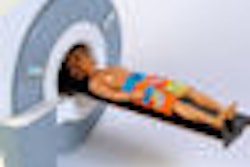The use of radiation therapy to treat pediatric low-grade glioma, the most commonly diagnosed brain cancer in children, is controversial due to the severe, adverse, late effects this treatment can cause. But the long-term outcomes of patients who participated in a large, nearly decade-long clinical trial are encouraging.
Patients diagnosed with pediatric low-grade glioma, for whom radiation therapy was clinically necessary in lieu of or in addition to surgery and/or chemotherapy, were irradiated with a 10-mm clinical target volume margin at St. Jude Children's Research Hospital in Memphis, TN. Researchers reported that patients not only had a 10-year survival rate of 74%, but that their cognitive functions were largely preserved.
The findings of the study, which was designed to test the hypothesis that this treatment would reduce adverse effects without affecting the rate of treatment failure, were published in the August 1 issue of the Journal of Clinical Oncology (2009, Vol. 27:22, pp. 3602-3604 and pp. 3691-3697).
Seventy-eight patients who received treatment between August 1997 and August 2006 participated in the clinical trial. The children were evenly divided by sex and ranged in age from 2.2 to 19.8 years (median 8.9 years). The patients were characterized according to specific clinical and treatment-related factors, including tumor location, prior chemotherapy, number of surgical procedures, and extent of resection before receiving conventional radiation therapy.
All patients received conformal radiation therapy over a six-week period. Each patient had an MRI exam during the third and fifth week of treatment to monitor tumor enlargement. Radiation therapy treatments were initiated within 90 days of diagnosis for 27 of 43 patients for whom this was the primary form of treatment.
Seventy-seven patients received a dose of 54 Gy in 1.8 Gy fractions, and one child with optic nerve glioma received 50.4 Gy. The planning target volume represented a 3- to 5-mm geometric expansion of the clinical target volume, an anatomically constrained 10-mm expansion of the gross residual tumor and/or tumor bed.
The children were examined every three months for the first two years, every six months for the next three years, and annually for the next five years. The median follow-up was 89 months.
During the first 12 months following treatment, patients were monitored for radiation therapy-induced treatment. With the exception of fatigue (45%), only 5% to 25% of the patients experienced loss of appetite, nausea, vomiting, headaches, vision impairment, motor weakness, ataxic gait, and/or cranial nerve deficits. Sixty-nine percent of the children used a 5-hydroxtryptiamine 3 receptor antagonist and 26% required corticosteroids. Six patients required hospitalization, and three patients had significant cyst expansion that required surgical intervention.
A total of nine patients developed cerebral vasculopathy, or damage to the blood vessels, identified by MRI exams that were performed annually. The mean cumulative incidence of vasculopathy was 4.79% six years following treatment. Principal investigator Dr. Thomas Merchant, division chief of radiation oncology, and colleagues expressed concern about this statistic, pointing out that late onset of vasculopathy indicates that additional incidents may be expected.
Disease control and survival
The five- and 10-year survival estimates for the entire patient cohort were 87.4% and 74.3%, respectively. Thirteen patients (16.7%) experienced disease progression, of whom four developed metastatic disease. One patient experienced a secondary malignancy.
Typical late effects of radiation therapy for children with low-grade glioma include cognitive dysfunction and endrocrinopathy. Cognitive testing was performed before radiation therapy treatment, six months following treatment, on an annual basis for the next five years, and at year 7 and year 10. Hormone replacement therapy was measured and audiology tests conducted.
The authors reported that age impacted baseline scores and changes over time, with the greatest decline in Child Behavior Checklist scores noted for children under 5 years of age. Each year of increasing age reduced IQ decline by 0.3% per year.
The 13 children diagnosed with neurofibromatosis type 1 had significantly lower baseline scores for reading, spelling, communication, and intelligence. During a five-year period, their average Child Behavior Checklist score declined from 44.2139 to 36.8819, as compared to the other 65 children who maintained an average score of 44.2806.
Growth hormone secretion abnormality had been diagnosed in 24% of tested patients before conformal radiation therapy, and 12% had precocious puberty. The authors report that the 10-year cumulative incidence of growth hormone replacement was 48.9%, thyroid hormone replacement was 64.0%, gonadotropin-releasing hormone analog therapy was 34.2%, and glucocorticoid replacement was 19.2%.
The cumulative incidence of hearing loss 10 years after treatment did not exceed 5.7%, but only nine patients experienced hearing loss at any frequency. Cochlear dose levels that exceeded 45 Gy in 16 patients resulted in statistically significant higher rates of increased hearing threshold in the right ear.
The authors emphasize that younger patients receiving treatment are more susceptible to adverse late effects than older patients; therefore, patients for this treatment must be carefully selected. They also recommend that all patients be tested for cognitive function at baseline, because this may differ considerably on a patient-to-patient basis. If this assessment is not made, the late effects of radiation therapy may be exaggerated.
With the availability of stereotactic radiation therapy, intensity-modulated radiation therapy, and proton beam radiotherapy, St. Jude's radiation oncology department has reduced its parameters for clinical target volume by half, to 5 mm. However, the authors caution that because planning target volumes can change, radiation oncologists need to remain vigilant throughout the course of treatment.
By Cynthia E. Keen
AuntMinnie.com staff writer
November 2, 2009
Related Reading
Cognitive defects seen with radiotherapy for low-grade glioma, August 11, 2009
GammaKnife provides local control for some low-grade gliomas, December 22, 2008
Quality of life impaired for children with brain tumors, September 15, 2009
Brain cancer takes long-term toll on children, August 22, 2005
Copyright © 2009 AuntMinnie.com



















